30 + Realistic Uses for Vinegar
Sitting on a big bottle of vinegar, but you don’t know what to do with it more than making volcano science projects and pickles? Here are realistic uses for vinegar all around your home and garden that can save you money.
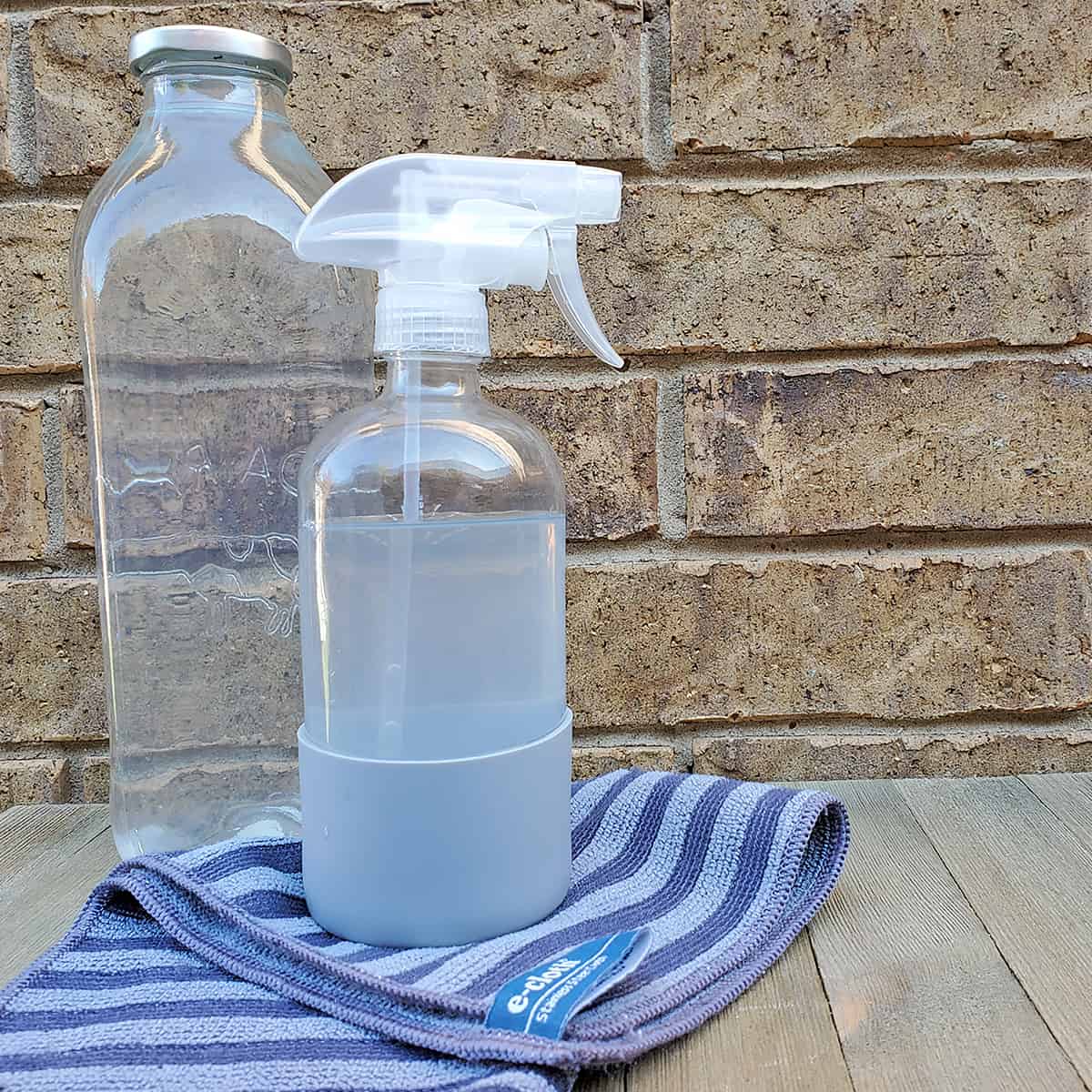
Have you seen those crazy lists of 1001 ways to use vinegar? I have, and the lists make my head swim. Some of the suggestions seem so farfetched, or there is a better natural alternative to fix the problem. It seems like someone made up a bunch of things to get a huge list.
Instead of looking at those uses of vinegar (a basic pantry staple you should have!) that just make you shake your head, let’s look at some realistic ways you can use vinegar around your home to make your life easier, and save money! Keep plenty stocked in your home for all of these amazing, realistic uses!
What Kind of Vinegar Should I Use?
Regular White Vinegar
- 5% Solution – whether white (made from fermented sugar cane) or distilled (made from just about any grain and cleaned through one extra process), this is the US standard household use vinegar that most people are used to using. This is also the standard vinegar strength used for pickling recipes by most canning companies and books. By the way, in Australia, the acetic acid level is only 4%.
- 6% Solution – this is usually called cleaning vinegar. The 1% added acid allows this vinegar to be 20% more effective in cleaning. You can use 5% if you can’t easily find 6% on the market.
- 10%, 20% & 30% These solutions are better for industrial or horticultural uses. They should be used with caution when using because they can harm your skin.
Apple Cider Vinegar
Apple Cider Vinegar (ACV) is a vinegar made from apple scraps. It has a milder flavor than regular white distilled vinegar. You can use it in pickling when coloration doesn’t matter as much, especially if you prefer the taste over regular vinegar. It’s also the choice for using on your skin as regular vinegar is more acidic and can be harmful.
I personally do not recommend using ACV for regular cleaning for the cost.
A brief history of vinegar and how it’s made from Howard Garrett’s DirtDoctor.com site:
“Vinegar is a wonderful organic tool that was discovered by accident [many years] ago when wine was accidentally allowed to ferment too long and turned sour. It can be made from many products, including beer, apples, berries, beets, corn, fruits, grains, honey, malt, maple syrup, melons, molasses, potatoes, rice, sorghum, and other foods containing sugar. Natural sugars from these food products are fermented into alcohol, which is then fermented into vinegar.” ***
Note: Most distilled white vinegar sold in the US is made of grains that were most likely grown as genetically modified (GMO) crops. If being organic is important to you, be sure to look for the organic label.
Uses for Vinegar in Your Kitchen
All-Purpose Cleaner
Try this formula for an all-purpose cleaner to use everywhere in your home.
In a spray bottle mix
- 2/3 vinegar to 1/3 warm water
- Add 10 drops of tea tree oil (this works as an antibacterial and antifungal element and smells pleasant, too!)
- Add a few drops of dishwashing soap
Vinegar is a natural antibacterial agent. With the addition of tea tree oil (which adds a pleasant pine scent), you’ve got more antibacterial and antifungal muscles to help you clean your home.
If that pine scent is not your favorite, feel free to add a few drops of your favorite essential oil to the mix. While vinegar does have a pungent smell when first sprayed, it dissipates fairly quickly, and your essential oil will help mask the smell.
PLEASE NOTE – this cleaner is not intended for marble, stone, granite surfaces or waxed natural woods. Please check with your manufacturer for the correct cleaner for marble and granite.
Want some scented cleaner? Try these ideas to make cleaning vinegar smell better!
Floor Cleaner
Use the above mixture (I keep a separate spray bottle without the essential oil) in a spray bottle or your reusable spray mop’s bottle to clean your floors. It’s a quick way to mop your floors between deep cleaning.
Dishwasher Rinse Aid
Instead of spending money on commercial rinse aid, try filling your compartment with 5% white, distilled vinegar. It works to cut soap and hard water stains and is much less expensive than the rinse aids you can purchase.
Clean Coffee Pot and Kettles
The leftover minerals in coffee pots and kettles can look gross, as well as leave undesirable flavors behind. You can run vinegar through a cycle on your coffee pot to help remove the buildup within your machine, and allow it to sit inside the coffee pot to remove any buildup there. After a time, run another cycle with clean water and rinse out your pot.
This works on regular and electric kettles, as well.
Cleaning/deodorizing disposals & drains
Just like baking soda, vinegar has a huge variety of uses around the house. But when you put them both together – BOOM!
Mix:
- 1/2 C of baking soda
- 1 C white distilled vinegar
into the drain.
The bubbles were so fun to watch, yet they are doing a good job to break down the buildup and help sanitize the drain. Follow it up with some dish soap and hot water and turn on your disposal to rinse it all away.
Hint: Before rinsing away, use an old toothbrush to take some of the leftover slurry and scrub at your drainpipe and gasket cover to get them nice and clean, too!
This used to be my kids’ favorite chore to do weekly. Now they are big and don’t enjoy it anymore, but it’s still something we do weekly.
In Canning
Not only should you use vinegar to wipe the rims off your canning jar to help create a tight seal, but you can also add 1/4C vinegar to your canner in the water (not in the jar). It helps keep the white buildup off your jars. It will, however, discolor your rings, but I’ll take that over having to scrub those jars clean every time!
Pest control
When you’re overrun by those little, tiny gnats that come in with your fruit, you can build a trap to get rid of them.
In a small bowl (we use a small ramekin), we place
- 1/2C Vinegar
- 1/2 TB Sugar
- 2-3 squirts of dish soap.
Mix until the sugar has dissolved. Place one ramekin in any area where you have fruit stored and near your sink. It may take a day or two, but eventually, you sill see the bowl fill up, and the population of gnats go down. We replace the bowl every other day or so.
*Note, you can use apple cider vinegar in place of the white vinegar + sugar.
Scrubbing cleaner
Recipe:
- 1/4 C baking soda
- Few drops of liquid soap
- Splash of vinegar
Directions
Create a paste from the baking soda and liquid soap, then add the vinegar and scrub away!
Maintain Good Seals
On fridge doors and dishwasher doors, the seals can begin to lose proper seal insulation because of food and grime buildup. Simply use straight vinegar on a cleaning cloth and gently wipe down the rubber gasket seals and the areas on the doors where they connect.
Uses for Vinegar in Your Laundry
Fabric Softener
Whether your machine has an automatic fabric softener compartment or you use a Downy ball , vinegar works as a laundry softening agent. It helps remove the build-up of soap in your fabrics (especially things like towels), which increases the softness in your fabrics.
And the bonus is that it doesn’t impart a smell (if you’re like me and don’t like your clothes to smell of flowery fake smells), and has an antibacterial property to help clean your clothes fully!
Remove Organic Stains
Grass and mud stains can really make doing laundry frustrating! If you have organic stains on sports clothes or kids’ play clothes, soak them in full-strength white vinegar for 30-60 minutes. Scrub if needed. Wash as normal, but check to see if the stain is still there before drying.
If your stain is still there, you can use the baking soda paste trick I’ve shown you before. Place a baking soda paste, scrub with a cleaning toothbrush, allow to sit, then wash as normal with an added 2 C of vinegar to the washload.
Washing Refresher
When you’ve done a load of laundry, but forgot to throw it into the dryer or hang it on the line, the next time you open your machine can leave you with a not-so-nice, mildewy surprise. That’s the smell. Mildew. Run your wash again in a rinse cycle with 2-3 cups of vinegar to help get rid of the mildew and smell it leaves behind.
Brighten Your Whites
Add 1C of white, distilled vinegar to a large stockpot of water and bring to a boil , then turn off the heat. Add any socks, or a t-shirt or two you’d like to brighten and allow them to soak overnight. Wash as normal.
Clean Dank Sports Funk
Soaking your exercise clothes in a tub or sink full of cold water and 2 C of vinegar will help remove the exercise funk that can build up in synthetic clothing before they hit the laundry. Since those materials are meant to repel water, simple laundering may not remove all of the smell. And again, use vinegar as a rinse aid to add another punch!
Uses for Vinegar in the Bathroom
As a note, most of these uses would be better using organic apple cider vinegar than straight white distilled vinegar for applications to the skin. Use only organic ACV with the mother included to ensure you are getting truly organic that isn’t just vinegar with food coloring.
Natural Hair Rinse
1 TB of apple cider vinegar to 1C of warm water. Rinse through hair after shampooing. This helps remove soap residue, closes the hair follicles for smoother hair, and helps correct the pH balance.
Soothe Itchy Skin
With its anti-inflammatory properties, ACV can help soothe itchy skin. Run 1 C of ACV with a warm bath (not hot as heat can irritate the skin further), and enjoy a good soak!
Skin Toner
Mix 1:1 mixture of ACV to act as a skin toner. This helps balance the pH levels in your skin, especially for those with oily complexions.
And because ACV can help dissolve dead skin cells, putting a few drops in with your body lotion can help brighten your skin all over!
Treat Dandruff
Mixing a little ACV into your shampoo can help manage mild dandruff. Not only does it help remove the flakey skin, it can bring relief from the itch associated with it.
Clean Makeup Brushes
Sure, water and soap can help clean makeup residue from your brushes. But to really disinfect them, use a solution of water and vinegar to dip your burshes into. Allow the brushes to be wet for a few minutes before rinsing.
Uses for Vinegar in Your Home
Pet stains/odors
When your pet has an indoor accident, you can help clean and deodorize the spot by blotting with a clean rag or paper towel to get as much of the liquid out as possible. Then spray with vinegar, scrub, and blot. Repeat. You may choose to use an enzymatic cleaner if you feel it needs more.
Window Cleaner
- 1/4 C rubbing alcohol
- 1/3 C vinegar
- 3 C Water
Mix in a spray bottle, then spray on windows and wipe with a microfiber cloth or newspaper. Try not to do this on a sunny day when the sun is shining into your windows.
Carpet Cleaner
When using a carpet shampooer, use straight vinegar instead of the soap to help clean your carpets. We do a 1:1 hot water and vinegar solution and use the machine in a regular manner. This helps clean your carpets without leaving behind the soapy residue that attracts more dirt.
Clean flower vases
Pour vinegar into your flower vase and allow to soak. Then put a few tablespoons of uncooked rice in, and shake briskly. The rice will serve to ‘scrub away’ the dissolved buildup on the glass surface. Rinse with cool water.
Freshen Mattresses
In the same way, we clean the carpet, vacuum the mattresses once a month, and then spray down with vinegar to help refresh them.
Hard water/mineral buildup
The white crusty buildup on your faucets and showerhead is usually mineral buildup. It’s also why you get spotting on your stainless steel fixtures, too. You can use vinegar to help remove those deposits to bring the shine back to your fixtures!
Spray a little vinegar on your faucet at the joints where the buildup occurs. Allow it to soak, then use a cleaning toothbrush to scrub away the minerals. wipe with a clean cloth.
On your faucet head and shower head, wrap each with a ziptop baggie full of vinegar, and use a rubber band to secure it. Allow to soak there overnight, and you’ll be amazed at how much of the mineral buildup is gone!.
Remove Soap Scum
Whether in your washing machine, dishwasher or shower doors/walls, soap tends to build up and cause a scum that is displeasing to look at.
To remove, use a rag dipped in vinegar to wipe down those surfaces to remove the soap sediment after every few uses to prevent buildup.
If it is particularly thick, you can dip a scrubbie in vinegar, use some baking soda, and scrub the shower door or wall to remove the buildup.
Clean Germs
Use a 1:1 ratio of vinegar to water to create a germ-fighting surface cleaner to use on doorknobs, toilet handles, light switches, and all areas where hands tend to touch to help control the germs that cause colds and flus. You can spray safe areas (like doorknobs and surfaces) and allow the solution to sit for at least five minutes before wiping. For light switches, wipe with a cloth.
Clean Sports Equipment
Because sports equipment work close to the skin can harbor bacteria from sweat, wiping down said equipment with vinegar and a clean cloth should be done routinely – even after every use. Not only does it help remove any mildew issues and smells, but it also helps ensure that your children’s skin is better protected by having clean equipment against their skin.
Uses for Vinegar in Your Garden
Weed control
Instead of using a harsh chemical that has been proven to cause cancer , you can turn to regular vinegar’s big brother, 20% acidic vinegar, to be a great weed control option. We especially love this in controlling the green growth in the cracks in our driveway and sidewalks.
Howard Garrett’s Herbicide
- 1 gallon of 10% -20% vinegar –
- Add 1 ounce orange oil
- 1 teaspoon dish soap
- Do not add water
Shake up the jug to fully incorporate the solution. Spray onto green leaves (remember, this will kill ALL green leaves) on a hot sunny day. Repeat after rain or morning dew.
Clean Pots
Plastic and terra cotta pots can develop stains from minerals and salts in water and planting compounds. Use a 1:1 vinegar and water solution with a few squirts of dish soap to clean and disinfect your pots.
Wrapping Up
Much like Windex from My Big Fat Greek Wedding, vinegar has been given some mighty big superpowers to cure the world’s ills. I hope that this list has given you ideas about how you can realistically use this wonder-liquid to help you save money in your own home, save a little time, and use less caustic cleaners to protect your family’s health.
What are some of the ways you use vinegar in your home?

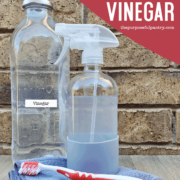

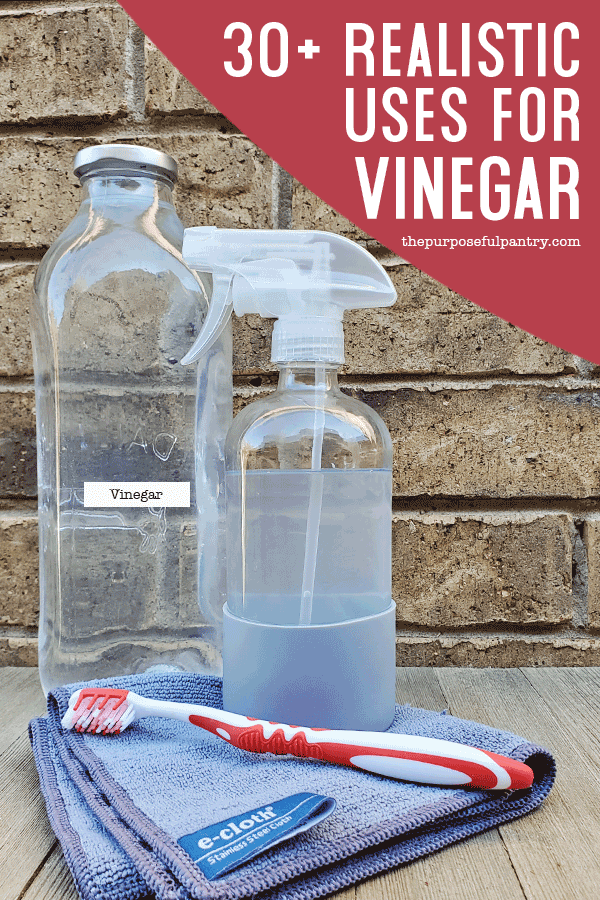
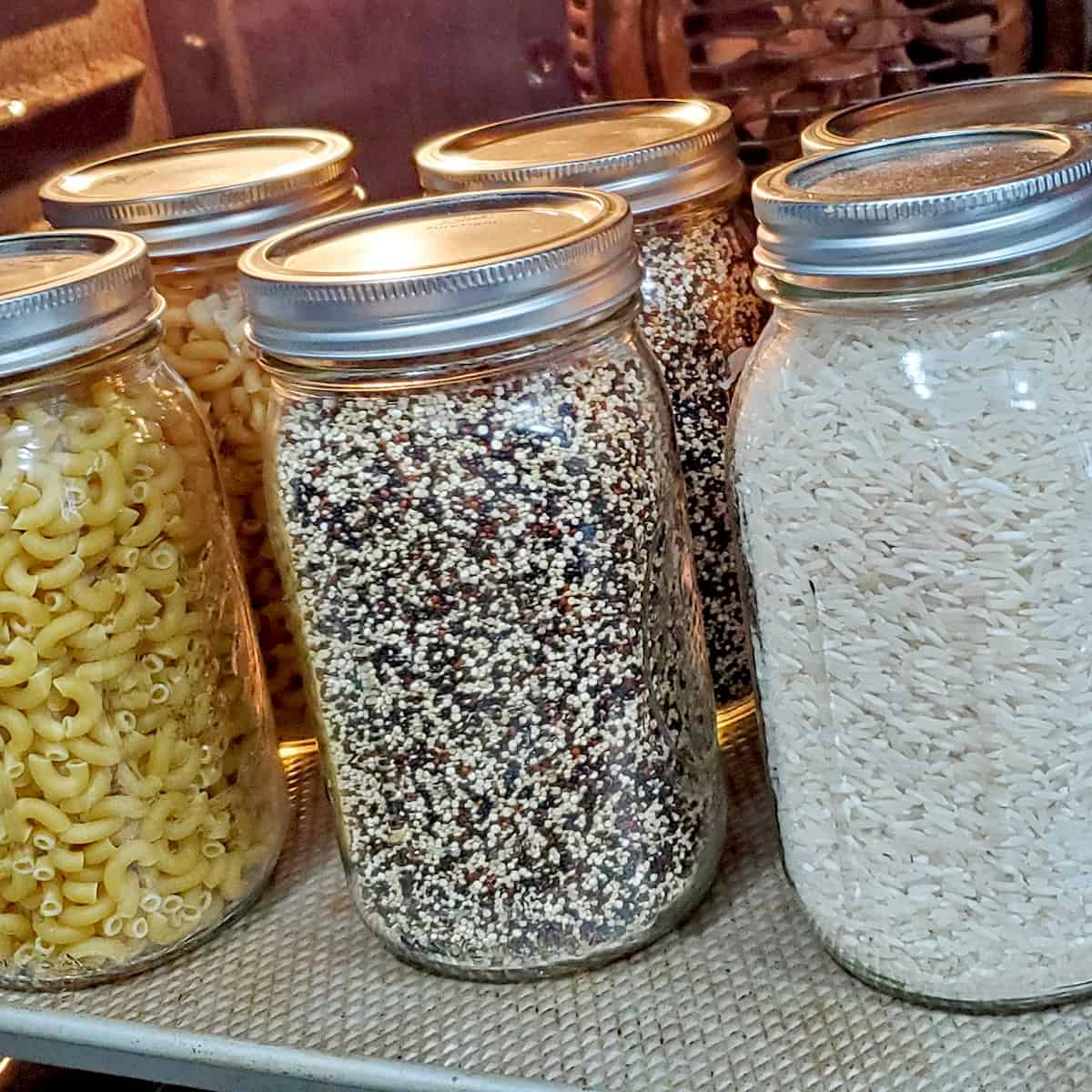
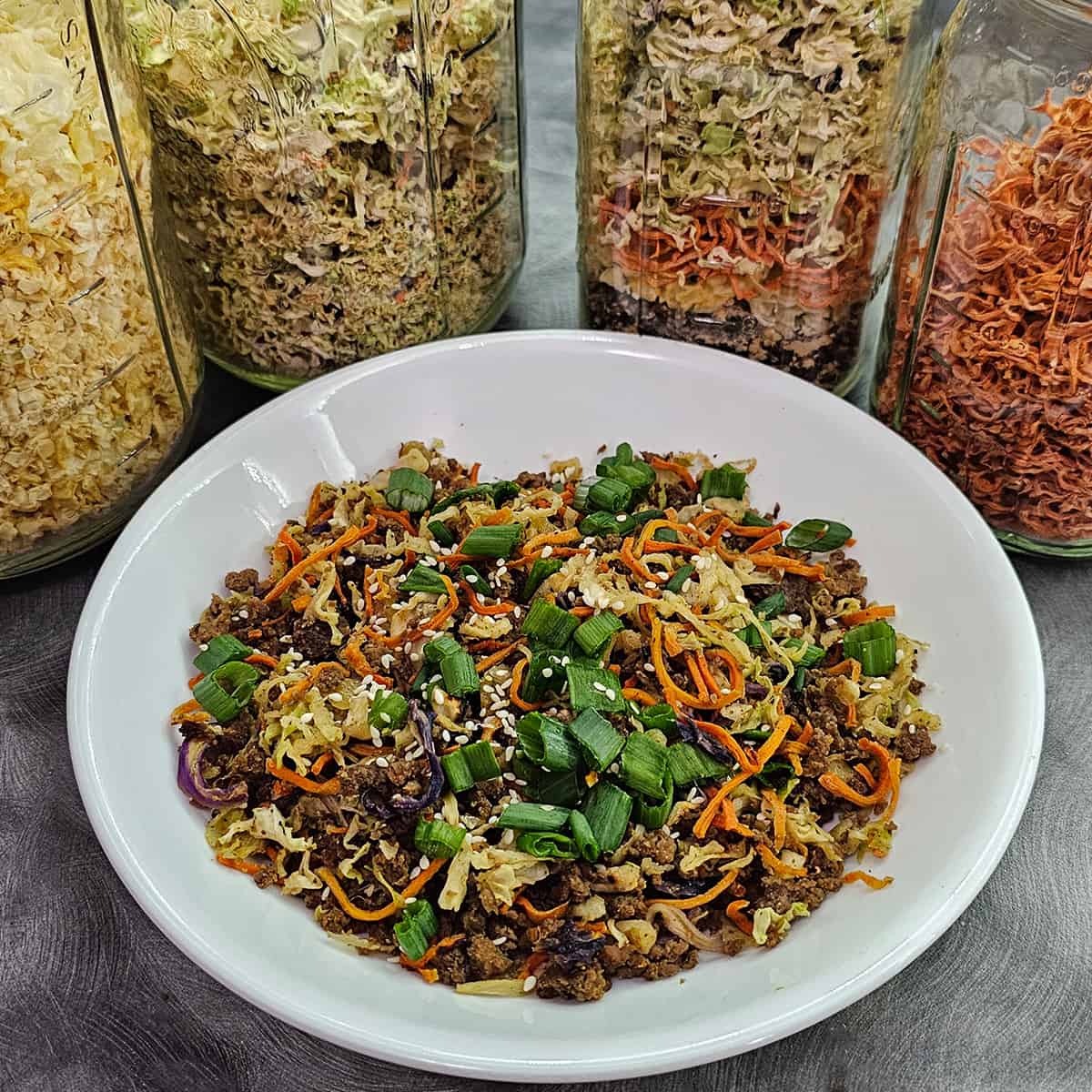
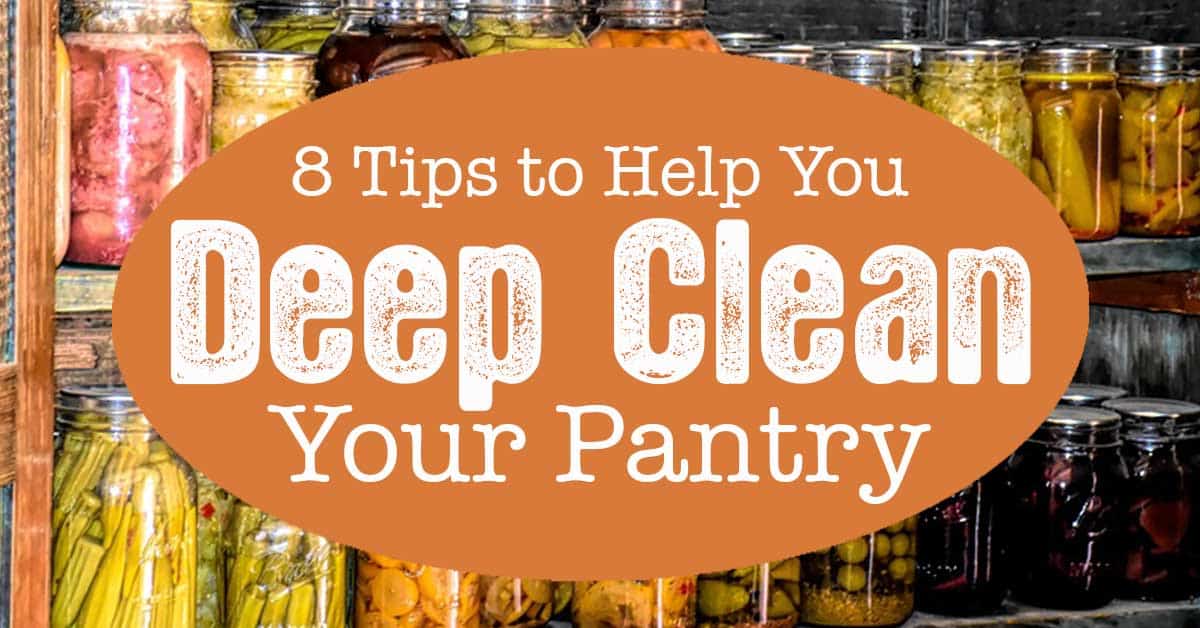
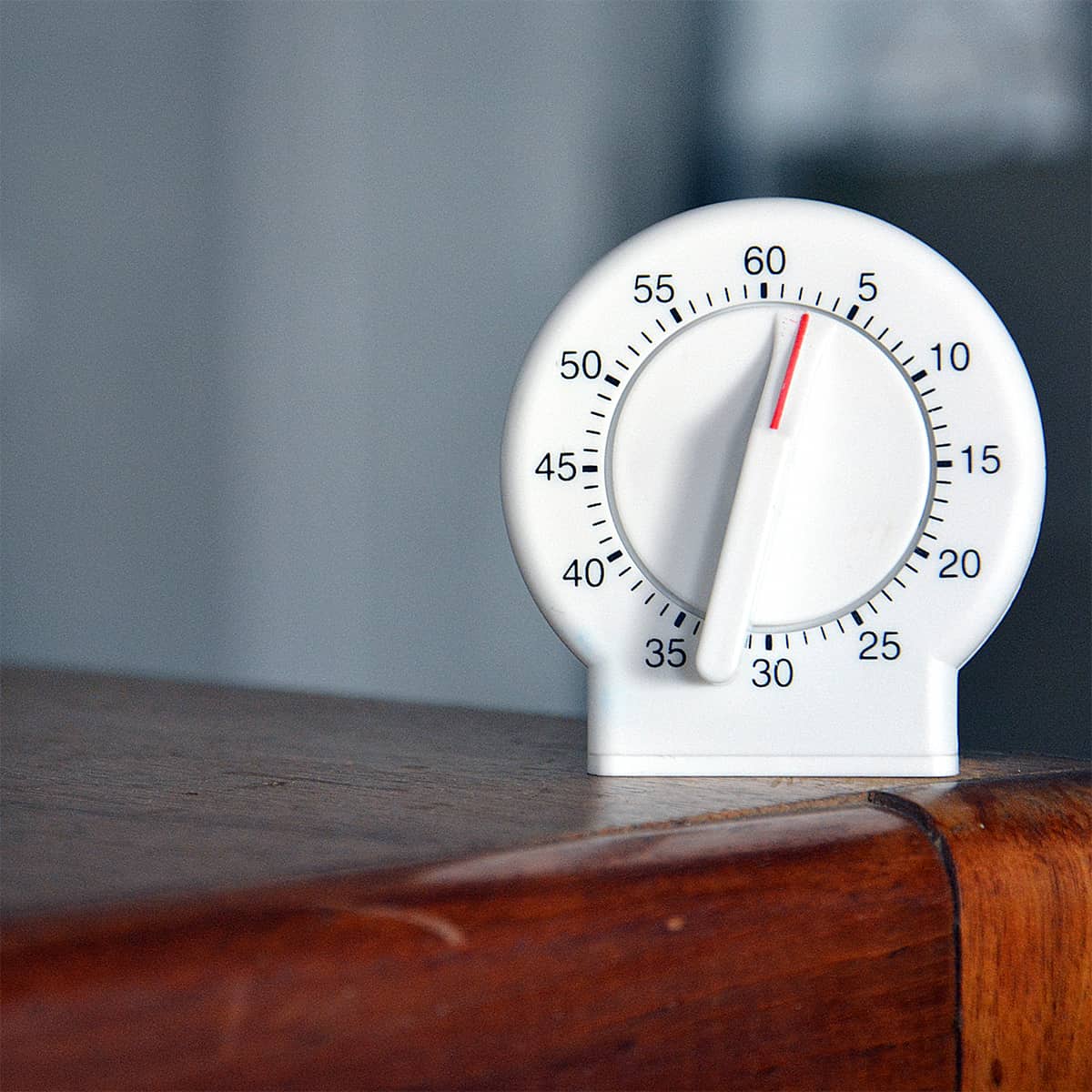
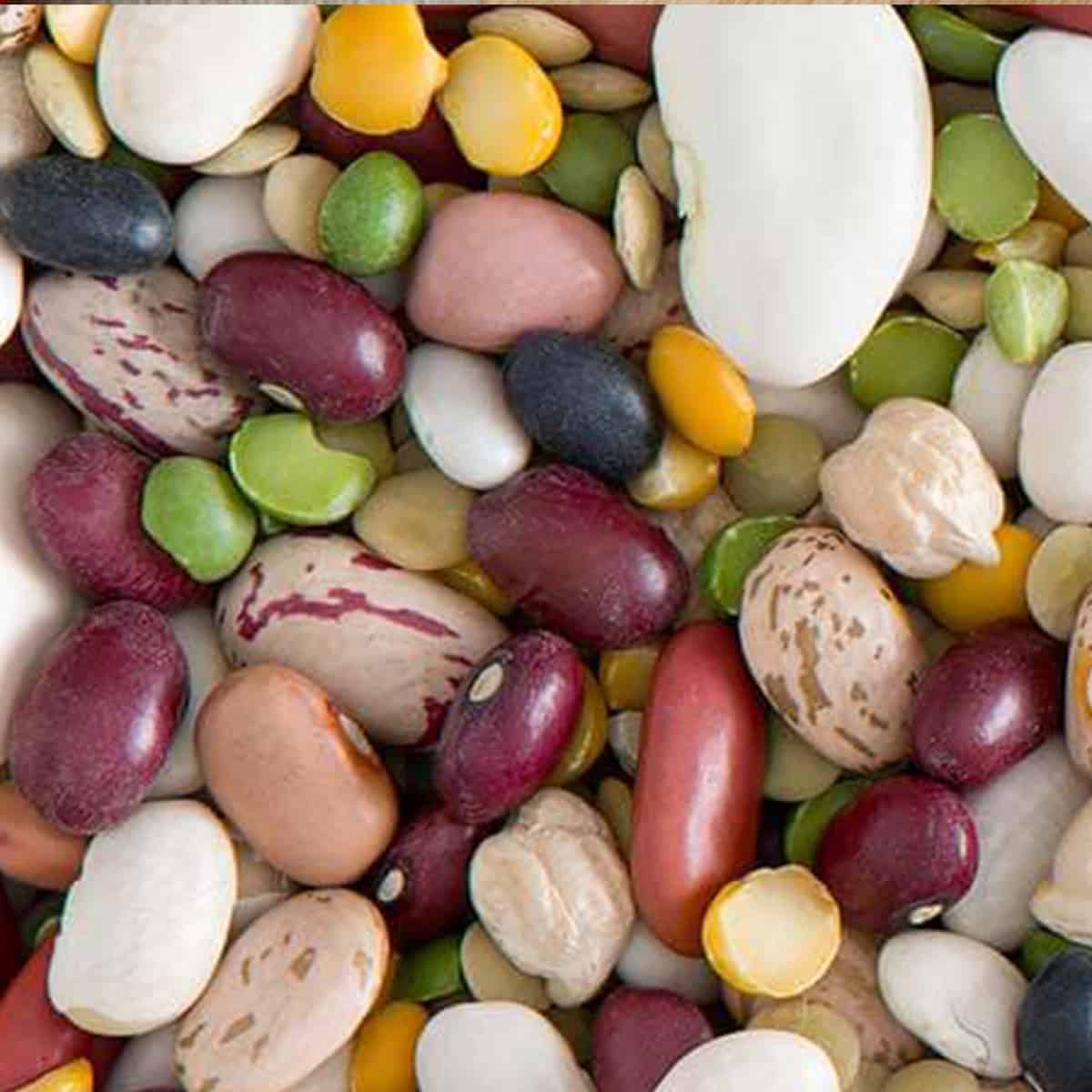
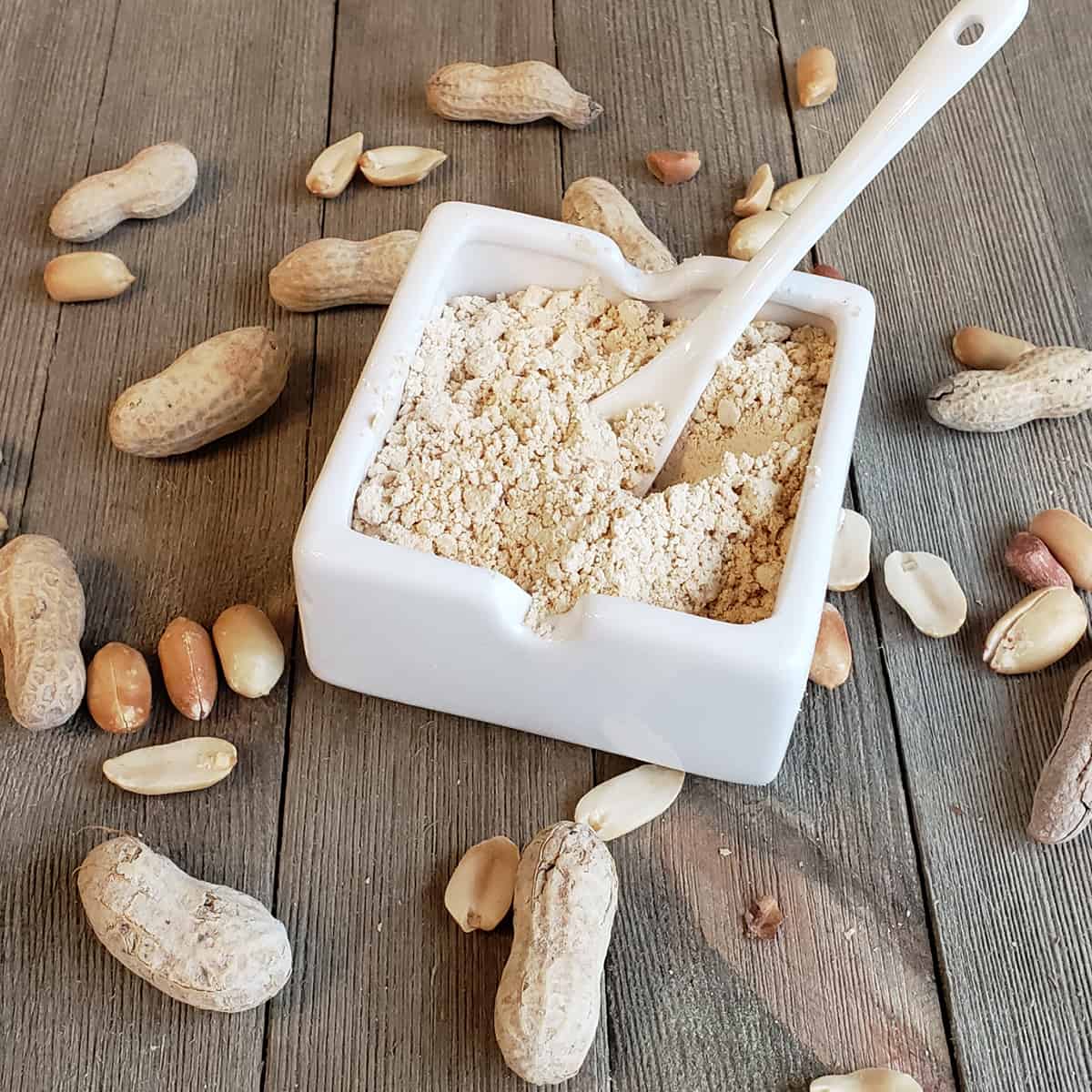
This is a good list. I would add a few comments based on experience: First off, using vinegar for killing gnats: well it does work and I have found that the sugar is completely unnecessary. I just use the ACV and a bit of dish soap, homemade is fine as well.
For the hair rinse, it doesn’t leave a smell after UNLESS you are like me, and VERY warm blooded or it is in the summer. I tend to be a warm person, and when my body heats up, well…so does the vinegar smell on my hair. I just use less and dilute it well.
Also, I ONLY use grain-based white vinegar. (Finding ORGANIC is VERY hard, and VERY expensive IF you can find it at all…so sad!) Almost ALL white vinegars are now made using: petroleum!!! It is difficult to find any that are grain based any more as well, but I have found the 1/2 gallon size of Essentials Everyday is grain based. Their gallon size is not, and certainly Heinz, the “staple” white vinegar is not, either. I guess it is a preference whether you want to use GMO grains, or petroleum, I have chosen the GMO’s. Not a great choice, but there it is. Just be sure to look for the “made from selected sun ripened grain” as opposed to simply “diluted to 5% acidity”.
Also, the 20% (haven’t found 10%) is ALWAYS made using petroleum.
These are very disturbing issues, I grant you. I dislike so much not being able to find a reasonably priced organic, if at all, and certainly don’t like using GMO’s OR petroleum.
I do have the 20% for my weed needs, and it works! Adding some salt to the vinegar helps keep hardy blackberries and the other vegetation I don’t want growing in places around works well, too. I have even used it on poison oak found near my foundation, and it worked! I pour the vinegar and then top it with salt. (This works well in the heat of summer sun, but not sure how well it would in the winter with rain…)Of course, you wouldn’t use this anywhere that you planned to grow anything else, as the salt will ‘kill” the ground with repeated use.
Those are my “tips” and thanks for the very nice post!
Thanks for sharing your experience!